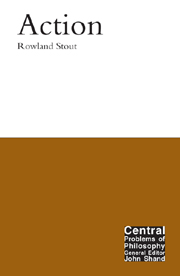Book contents
- Frontmatter
- Contents
- Acknowledgements
- 1 Introduction: inward-looking and outward-looking approaches to agency
- 2 Acting for a reason
- 3 Reasons and passions
- 4 Agent causation
- 5 Mental causation
- 6 Deviant causal chains and causal processes
- 7 Acting with an intention
- 8 Prior intention
- 9 The metaphysics of action
- Conclusion
- Notes
- Suggestions for further reading
- References
- Index
7 - Acting with an intention
- Frontmatter
- Contents
- Acknowledgements
- 1 Introduction: inward-looking and outward-looking approaches to agency
- 2 Acting for a reason
- 3 Reasons and passions
- 4 Agent causation
- 5 Mental causation
- 6 Deviant causal chains and causal processes
- 7 Acting with an intention
- 8 Prior intention
- 9 The metaphysics of action
- Conclusion
- Notes
- Suggestions for further reading
- References
- Index
Summary
Introduction
It seems very natural to suppose that acting intentionally is acting with an intention. Since having an intention is being in a certain state of mind, it follows that acting intentionally essentially involves being in a certain state of mind. This may appear to support an inwardlooking approach to agency: an approach that attempts to find the essence of agency in some aspect of the agent's state of mind. But this defence of an inward-looking approach depends on an inwardlooking approach to intentions. Its correctness depends on intentions being mental entities that can be understood independently of their role in intentional action. For example, if intentions have some intrinsic nature knowable by introspection to the agent, then understanding this intrinsic nature of intentions will provide an inward-looking understanding of agency. But if intentions can only be understood in terms of their role in intentional action, then explaining intentional action in terms of intentions is to go around in a circle, and this particular inward-looking approach would be undermined. An outward-looking approach to action would go with an outward-looking approach to intentions.
It is the task of both this chapter and Chapter 8 to investigate whether we can derive a theory of intentions from a theory of intentional action. Should we try to understand what it is to have an intention in terms of what it is to act intentionally or should we try to understand what it is to have an intention independently of what it is to act intentionally? In this chapter I focus specifically on intentions that one has while acting.
- Type
- Chapter
- Information
- Action , pp. 99 - 118Publisher: Acumen PublishingPrint publication year: 2005



